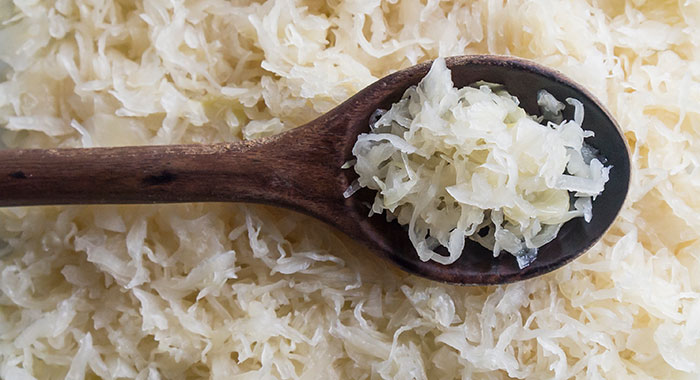
Pronounce it: sow-er-krowt
A diet staple of Germany and much of Central Europe, this is finely sliced cabbage subjected to lactic-acid fermentation.
The process begins by adding salt to prepared cabbage; this draws liquid from it and encourages the conversion of natural sugars on the cabbage into lactic acid, which together with the salt preserves the cabbage. Originally a standby during winter, it is now credited with excellent health benefits when eaten raw because of the creation of probiotics during the fermentation.
Sauerkraut is the European equivalent of Korea’s kimchi, and differs by being pickled finely sliced rather than in big sections and by rarely being made with other flavouring ingredients, except for a little caraway seed or similar.
Eaten raw or cooked throughout the year, at home and in restaurants; in fine dining it is sometimes even served drenched in champagne.
Read our guides on the health benefits of sauerkraut and the health benefits of fermenting.
Availability
Commercially available cans and jars are available year round and provided they have no false additions will be very good and wholesome. It can be homemade whenever there is suitable cabbage, usually solid white cabbage, but all types of cabbage including red cabbage can be pickled.
Choose the best
The main difference between commercially available styles from different countries is how finely the cabbage is sliced. Sauerkraut that is finely sliced rather than roughly chopped makes this essentially rustic food seem classier and is easier to keep in a sandwich. Sauerkraut made in Poland is usually very good.
It can be rinsed before use but will still taste salty. There should also be a sweetness from the cabbage itself and further depth of flavour as a result of the fermentation.
Pickled red cabbage often has additions of spices, such as allspice berries, cumin or coriander, black or white peppercorns.
Store it
Once a container is opened, sauerkraut must always be kept beneath its preserving liquid; it’s common to add a weight of some kind to ensure this. It will then last a very long time and is best kept both covered and in the refrigerator. Use very clean utensils to take it from the container or you run the risk of contaminating it, or even encouraging other processes that might change its flavour and safety.
Cook it
Sauerkraut is very simple to make at home and there are many recipes available online. Be certain to follow instructions concerning hygiene. It is ready in a matter of a few weeks.
Be the first to comment on "Sauerkraut"